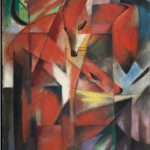
Berlin.- The exhibition “All Cannibals?” at me Collectors Room from May 29th to August 21st, scrutinizes the topic of cannibalism (anthropophagy) in art. Curator Jeanette Zwingenberger fosters a dialogue between historical works (etchings, paintings, ethnographic photographs, and cult objects) and works from contemporary art. Shown are current works from the mediums of video, installation, photography, sculpture, drawing, and painting that explore the issue of anthropophagy in a mindscape that is often both uncanny and playful at the same time.
 The juxtaposition of past and present reveals intersections between metaphorical and literally concrete planes. Various motif-related aspects — like sacrifices, primordial fears, and sensually narrated elements of creepiness — are presented from an art-historical perspective, their many layers illuminated.
The juxtaposition of past and present reveals intersections between metaphorical and literally concrete planes. Various motif-related aspects — like sacrifices, primordial fears, and sensually narrated elements of creepiness — are presented from an art-historical perspective, their many layers illuminated.
A total of 100 works, most of which originate from private collections, by 40 international artists are being shown in the exhibition, partly chronologically and partly thematically presented. The arrangement follows headings like History, Myths & Fairy Tales, Solidarity of the Flesh, Goya and His Successors, and Holy and Secular Cults. Anthropophagy can be found in the myths of all cultures and ages, with examples ranging from antiquity, the Bible, or folk tales to classicist authors and modern horror movies. The recurring motifs of desire and brutality can likewise be found in modern and contemporary art. The concept for the exhibition emerged from the observation that the theme of consumable flesh seems to be gaining in significance within many current art works. Due to today’s clinical distance to one’s own body, a need arises to probe that which is hidden inside of us. These contemporary works demonstrate a tendency to represent this consumption in a more radical and direct (but also violent) manner than was the case in works of classic modernism, which often had a playful or ironic note. The Surrealists, for instance, though quite fascinated by cannibalistic delicacies, remained focused on the erotic aspects of cannibalism.
The exhibition fields the question as to whether we as people are not, fundamentally speaking, all potential cannibals. Along this vein, the exploration of cannibalism should always first start with us. The issues manifesting in the artistic representation of cannibalism reference basic problems relating to one’s self-perception, to associations with one’s own flesh, and also to dealings between people. Thus, the metaphorical consumption is able to encourage the fostering of solidarity with others and to expose victim-perpetrator associations. In art, this bipolarity is shown through the oscillation between desire and violence, eroticism and power.
 Artists included in the exhibition are Makoto Aida, Gilles Barbier, Norbert Bisky, Michaël Borremans, Patty Chang, Jake & Dinos Chapman, Erik Dietman, Wim Delvoye, Marcel Dzama, Renato Garza Cervera, Will Cotton, James Ensor, Camille de Galbert, Francisco de Goya, J. J. Grandville, Pieter Hugo, Melissa Ichiuji, John Isaacs, Oda Jaune, Michel Journiac, Dana Schutz, Sandra Vasquez de la Horra, Adriana Varejâo, Saverio Lucariello, Frédérique Loutz, Patrizio Di Massimo, Yasumasa Morimura, Théo Mercier, Philippe Mayaux, Vik Muniz, Wangechi Mutu, Álvaro Oyarzún, Chantalpetit, Giov. Battista Podesta, Odilon Redon, Félicien Rops, Bettina Rheims, Cindy Sherman, Toshio Saeki, Joel-Peter Witkin, Ralf Ziervogel and Jérôme Zonder.
Artists included in the exhibition are Makoto Aida, Gilles Barbier, Norbert Bisky, Michaël Borremans, Patty Chang, Jake & Dinos Chapman, Erik Dietman, Wim Delvoye, Marcel Dzama, Renato Garza Cervera, Will Cotton, James Ensor, Camille de Galbert, Francisco de Goya, J. J. Grandville, Pieter Hugo, Melissa Ichiuji, John Isaacs, Oda Jaune, Michel Journiac, Dana Schutz, Sandra Vasquez de la Horra, Adriana Varejâo, Saverio Lucariello, Frédérique Loutz, Patrizio Di Massimo, Yasumasa Morimura, Théo Mercier, Philippe Mayaux, Vik Muniz, Wangechi Mutu, Álvaro Oyarzún, Chantalpetit, Giov. Battista Podesta, Odilon Redon, Félicien Rops, Bettina Rheims, Cindy Sherman, Toshio Saeki, Joel-Peter Witkin, Ralf Ziervogel and Jérôme Zonder.
In a series of rotating exhibitions, the ‘me Collectors Room’ showcase the Olbricht Collection, containing works ranging from the early 16th century up to the present day. Selected curators are invited to give their own perspective on the collection, whose driving focus draws on the core themes of human existence: life, love, eros, transience and death. A set fixture at the venue is the Wunderkammer (or ‘cabinet of art and marvels’), containing works from the Renaissance and Baroque periods. Besides works of art though, other collector’s items are on display, such as rare postage stamps, art nouveau objects and toys. In the café, shop and lounge, visitors can find room to exchange ideas, as well as reflect on and enjoy a sensual experience of art.
During 2011 the theme of ‘collecting’ itself is also central to the programme. Besides discussions with international collectors (primarily, but not exclusively, of art), towards the end of the year they will also for the first time be holding reciprocal events with other private art collections. The residential and exhibition building, situated in the immediate vicinity of the Kunst-Werke Berlin, was designed by the architectural firm Düttmann + Kleymann in conjunction with Thomas Olbricht. The generous 1.300 sq m exhibition space enables a division of the room, which invites both a direct engagement with the collection, as well as flexible open spaces for visitors. Behind the high glass façade there are a number of amenities, such as a Café, a Shop and a lounge area, spread across two floors. Ample space then for visitors to exchange ideas about the things they have seen. Visit the gallery’s website at … http://www.me-berlin.com








